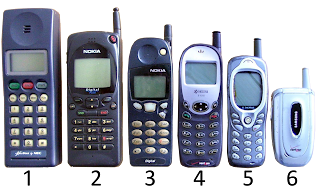
Featured above are various cell phones from 1992 to 2004.
Legend:
1. NEC Cellstar 500 series (1992)
2. Nokia 2110 series (1994)
3. Nokia 5120 (1998)
4. Kyocera 2135 (2002)
5. Audiovox CDM8300 (2002)
6. Samsung SCH-A650 (2004)
Picture located on Wikipedia.com: http://en.wikipedia.org/w/index.php?title=Mobile_phone&oldid=194348065. Accessed February 27, 2008.

4 comments:
I had one of number two. Those were the days.
It's shame that the picture doesn't include the iconic Motorola "brick" from the early 1990s, about 18 inches from top to bottom and really, really heavy.
No self-respecting Yuppie would be seen in public without one.
Cost well about £1,500 IIRC.
Someone's now making replicas with many modern features included. (See http://www.retrobrick.com/microt.html) for a picture.
Excellent presentation on the mobile revolution. Thoroughly enjoyed it. Keep up the good work!
Mobile phone has gone a long way since it came into being and it also changed the way of PR practitioners interacting with colleagues and customers.
Mobile phones are extremely useful and important in some cases. I can imagine that PR practitioners working for Northen Rock in these couple of months are keeping their phones on 24/7.
But I am also wondering whether the existance of mobile phone could ease PR practitioners' work or get them trapped with work at home rather than relax and chill out.
The answer might be: Since you love this job, it can't be bother.
Hi Sherry,
That is an interesting point you make. I think that there is the possibility of employees being a victim to their mobile technology if they are not careful. From the research and interviews I have done thus far, it is clear that boundaries need to be set by mobile users if they are to have a balance between work and personal life. I believe that a person’s connection to a mobile device can stem from what type of work environment exits. If an individual works for him or herself or is the only PR personal at a company, it seems that the expectation for being available is greater. Whereas, if a person works for a non-governmental organisation (NGO) the demand for them to be available might decrease. I wonder if there is a noticeable difference between senior and junior staff’s mobile device usage. Are more senior staff able to turn off their work outside of office hours or because there are more senior, is there an expectation to be available? These definite issues (or hazards) that surround the PR professional.
Post a Comment